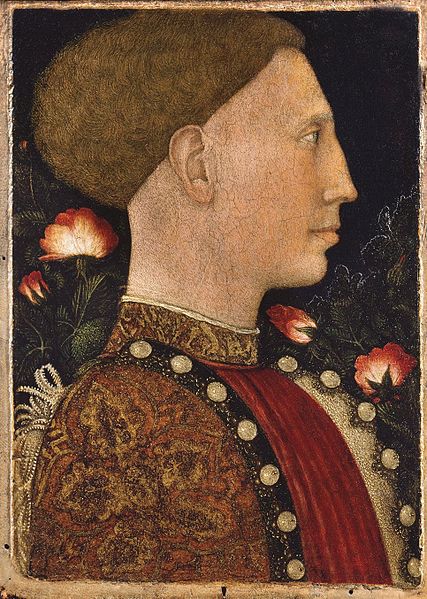The story of this painting is connected with two great painters, Jacopo Bellini and Pisanello, united in a six-month competition to paint a portrait of Leonello d’Este. We are in 1441 and a few months later he was to become Marquis of Ferrara, so he wanted a painting with which to present himself to his subjects. Unfortunately, Bellini’s work has not come down to us, but we know from documents that it was preferred to that of Pisanello, thus entering the Este collection.
In front of the ‘Portrait of Leonello’ one is immediately fascinated by the elegance of the details: the fine brocade dress embroidered with a large flower on the shoulder and embellished with pearl buttons fixed with a gold pin, the roses delicately surrounding his figure almost as if to form a natural frame, and finally Leonello’s regal and luminous face standing out clearly against the dark background. The face of the next Lord of Ferrara is characterised by detailed physiognomic features that recall an image that is still typically Gothic, from which, however, he departs by choosing to portray him in profile. In this decision there is a precise intention to refer to ancient art and thus to place himself in continuity with an ideal and perfect world. Shared by both the commissioner and the artist was a passion for ancient art, and the inspiration for portraying a new image of the Prince probably came from the effigies of ancient Roman emperors engraved on coins in Leonello’s collections of antiquities.
Pisanello created a profile whose distinctive feature is the hair: the blond locks are cut ‘a scutella’ and the forehead is shaven, as the French fashion of the time required. This iconic profile would be repeated on the recto of the six commemorative medals that the artist would design for Leonello between 1441 and 1444, while on the verso was an emblematic image with political meanings and allusions to virtue.
The painting underwent restoration by the Opificio delle Pietre Dure of Florence between 2004 and 2008, which led to the discovery that the black background was a later repainting, while the colour chosen by the painter for the sky was a beautiful blue that gives the painting a more natural appearance.
The original location of the painting is still uncertain, but the small size of the board and the defeat in the competition with Bellini could place the work in Leonello’s famous Studiolo in Belfiore, placed next to the Muses in a continuity of themes.
The painting was included in the 1835 inventory of the Costabili Gallery and was later purchased at auction by Alexandre Barker in 1871. The work was later found in the collection of Giovanni Morelli in Bergamo, who in his will decided to leave his entire collection to the Carrara Academy in Bergamo.







